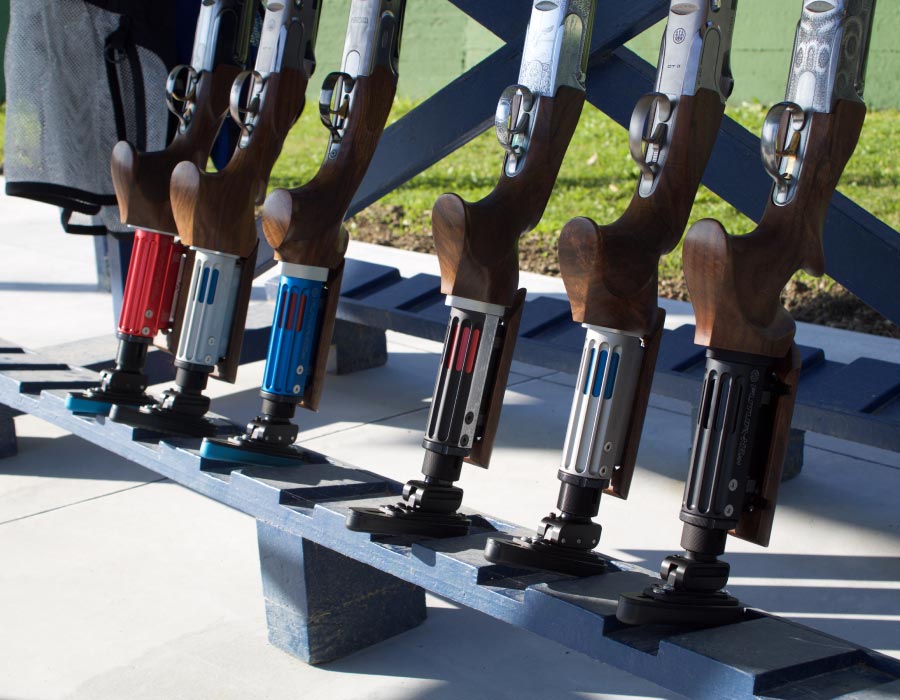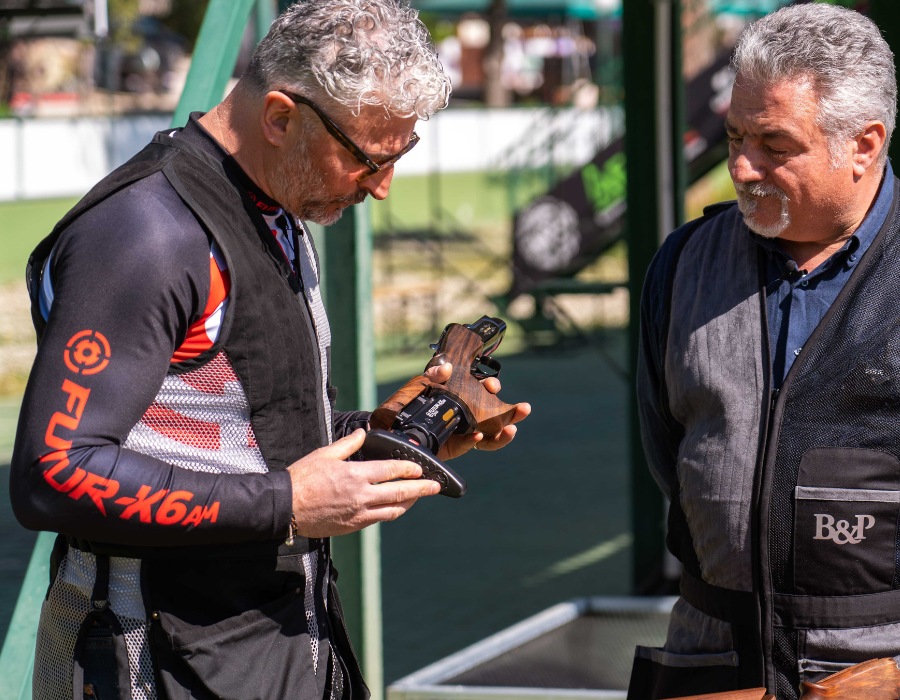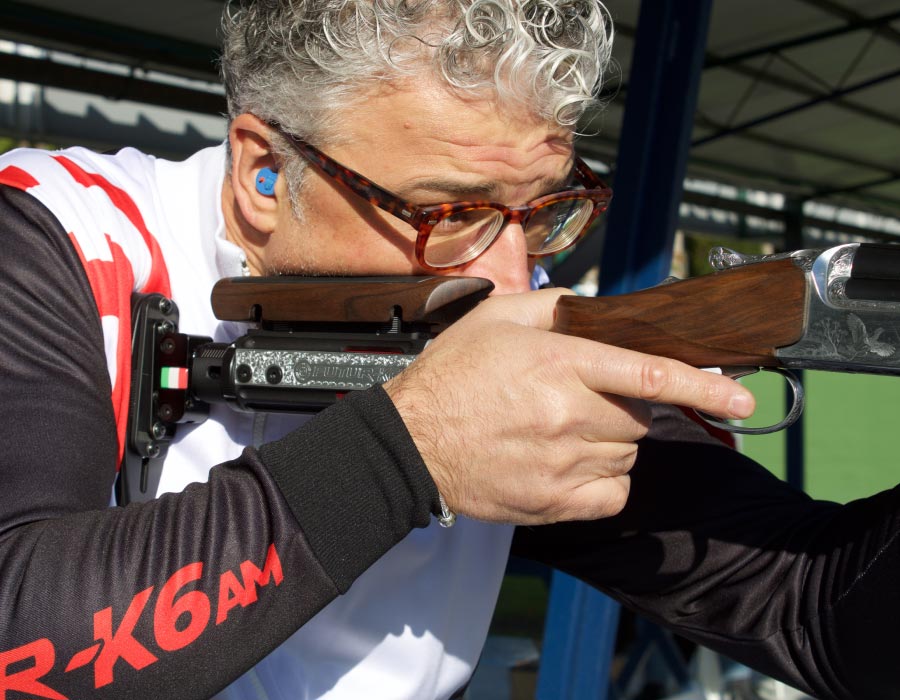To each his own concerning shotguns because our height and the length of our arms vary, and some are left-handed, and others are right-handed. In short, each shooter has their own unique physicality.
Your build greatly affects the way you shoulder a shotgun. And we know how an uncomfortable grip will affect the accuracy of the shot, and, as a result, a successful session. Without the right setting, it will be really difficult to hit the target.
Suitable equipment is also essential in any sport. Have you ever taken a run in shoes that don’t fit well? Or that are too small? After less than a hundred meters, your feet will beg for mercy, you will be tired, and you will seriously regret going to the track. Your session will be anything but pleasant, and you will soon get tired of shooting.
The same goes for any other discipline. Clay pigeon shooting is not exempt from this mantra. A sport in which every movement is calculated at the split second and nothing is enough to derail the plans of victory.
A “standard” shotgun, purchased in a closed box, will hardly adapt to your needs, forcing you to work harder than necessary before getting some decent results. Therefore, every shooter knows that, first of all, they must turn to a trusted gunsmith to give them the best experience.
Among all the components, you should pay extreme attention to the stock, because this part is the link between you and your shotgun. In this study, we will explain the advantages of an adjustable shotgun stock.
Stock, the link between the shooter and the shotgun
The stock is the most important component of the shotgun. In fact, it represents the point where the mechanics meet the man, where the cheek rests. Moreover, it is the tool that must be placed on the shoulder–prolonging the natural sight to align it with the barrel. In short, it is the extension of the shooter.
Therefore, its exact structure is considered one of the qualities necessary to achieve specific objectives. Its features then condition the purchase. It is better to find the right solution immediately, rather than having to go back to the store and change something every time. You will eventually spend more money.
Many failures, as soon as the trigger is pressed, are caused by stock measurements that are totally off-kilter, which are not suitable for the build of the person holding the shotgun.
Therefore, it is essential to have an adjustable shotgun stock.
Customization can be done in several ways.
Some sportsmen choose a new stock from the interchangeable ones on the market, which differ in lengths or folds. However, these remain in the range of standardized products.
Others remove or add wood thicknesses, applying butt plates or other sections.
But you can remedy everything and take action by getting a stock that makes flexibility its strength, like our Futur-K6AM, which offers an infinite variety of adjustments.

Other aspects of the stock
- It helps you take aim, aligning the eye to the height of the barrels.
- It constitutes the handle of the shotgun, therefore, it supports all the mechanics.
- It guarantees the balance of the shotgun.
- It softens the recoil phenomenon. It is able to direct the kinetic energy to the shoulder, as long as the recoil fits the shooter’s build well.
The advantages of an adjustable shotgun stock
Since the dawn of time, shotgun manufacturers have tried to design guns capable of being compatible with shooters from all over the world.
Following research and studies, some specific and important parameters have been identified over time, which are adaptable to any shotgun model on the market. By varying these measurements, it is possible to meet the peculiarities of a very high percentage of sportsmen. All this will greatly affect the outcome of the shot, which will be more accurate, even after the first few shots. Let’s look at the lengths that must fit perfectly.
The measures of the stock
Let’s start from the essential length, that of the whole stock. On average, as regards hunting shotguns, this is around 360 mm, while it can reach 370 mm for shotguns dedicated to sport shooting. This figure can change a lot depending on the build of the shooter’s body, ending up in a range that already starts from 365 mm.
As a result, the extension also depends on its use.
For example, a shorter stock is preferred for hunting since this constitution guarantees immediate aiming. Moreover, in hunting practice, speed is everything.
But a “short” stock can even be an advantage in the sporting clay because it makes it easy to reduce reaction times.
An extended stock facilitates the pursuit over long distances, which is why the target acquisition will be greater.

But what is the right length of the stock? Its extension must meet the size of the forearm of each shooter.
Basically, you have to pay attention to the length in the center, defined as the distance from the center of the stock (butt stock) to the trigger.
If this space is too long, the heel may drag on the lower part of the shoulder, or get caught in the bend of the elbow.
On the contrary, if we were dealing with a stock that was too short, the recoil of the shotgun would be amplified, which would then throw off the shooter’s balance and cause them to have pronounced shoulder and cheek pain.
The swings
Shooting on the platform is very different from what you can do in nature while hunting.
In the latter case, the folds are more accentuated to anticipate the trajectory of the game. In sporting, on the other hand, there is a tendency to follow the target with short swings, moving upwards with the target.
The “swings” defined above are different in Skeet, where the folds similar to hunting are preferred since you’ll have to chase targets that move in a similar way to hunting.
To find the right folds, our suggestion is to carry out some test shots, thinking about the movements of the pattern.
If the latter has gone too far left or right from the center of the target, we must get a lead on it.
The advantage
The deviation is the lateral movement of the axis. It is another substantial component, which leads us to prefer an adjustable shotgun stock. In fact, the advantage typically ranges between 4 and 8 mm and between 6 and 11 to the comb.
It is not advisable to opt for too great an advantage, because it could cause the shotgun to rotate at the shot, which would reduce the possibility of engaging the targets.
The advantage can refer to the heel or the toe. Why is this measurement so important?
The forces that come into play during a shooting session vary. The shooter puts two in the field, one at the entrance and the other at the exit.
Naturally, at the entrance, we are referring to the movement of the shotgun in the direction opposite the arm that is gripping the shotgun (which is to the left for right-handed shooters, and vice versa for left-handed shooters). On the contrary, it will be the opposite at the exit.
At the entrance, the movement is strong, while in the exit shots, we will have more and more difficulties. For this, the shooter needs “help” from the shotgun, which is naturally called advantage.
But you don’t have to overdo the advantage because having an excessively pronounced deviation can make you shoot out of step.
If the advantage is too much, you risk finding your aim ahead of the target in flight, and you will be forced to slow down your swing to reach the target.
This change affects the success of the shot. Shooting times must be identical for the left and right targets. So, you need to understand right away how to ration the deviations.
The pitch
This represents the inclination of the butt. This angle adjusts the inclination to the part of the shoulder where the shotgun is placed. If the angle is correct, maximum management of the shotgun will be a guarantee, providing safety and stability.
For this, the pitch must follow both the physicality of the shooter and their style.
As for their build, the angle tends to be less pronounced with significantly robust shooters, while the value moves towards zero in the presence of thinner athletes.
As for their style, those who prefer a technique that emphasizes a posture with the trunk tilted forward will prefer reducing the pitch.

The cant of the stock
The cant of the stock can also be detected after a few test shots.
If you notice a pattern that hurls too high or low, you have to act on the cant of the stock. You can do this by looking at the distance between the eye that is focusing on the target and the horizontal line of the shoulders.
Tip: first the stock, then the technique
Some shooters can immediately spot what’s wrong with their shot. Others, especially beginners, will begin to self-correct their technique, choosing unnatural postures to correct their shot.
In this way, wrong reflexes are created, and these setting defects will be hard to correct. So, at an early stage, it is best to get checked by an expert.
The position of the head is also very important regarding the stock.
As we have just mentioned, it is preferable to learn the technique immediately, and the same goes for posture. The position of the head is one of the first factors to be kept under control.
This section will help us understand just how important it is to have a stock perfectly compatible with our build–a stock that we really feel is “ours”.
Meanwhile, start from the position of the eyes. To avoid mistakes while shooting, the eye line must be perpendicular to the line of sight of the rib. Otherwise, you will “misfire”, and the clay will bolt.

Right-handed shooters usually tend to tilt to the right (left-handed shooters to the left), thus bringing the gaze into a situation that is quite diagonal to the shooting line. This is a mistake.
Now, let’s focus on the head, which should be placed on the nosepiece in a snug manner, considering the cheek, upper lip, and nose.
Remember that the nose must go towards the nosepiece. We must once again emphasize how vital it is to have strong and safe contact with the shotgun. Otherwise…you will be back at square one: you will start missing shots, and your stress on the platform will increase.
As we have mentioned several times, it is a good habit to practice at home, maybe standing in front of a mirror (with the shotgun unloaded, safety first of all).
A side note. The most common mistake is instinctively raising your head as soon as you call the target. On the one hand, this gesture will cause your eyes to lose alignment with the barrel, on the other hand, it will lead to an insufficient grip of the butt, with your face exposed to the recoil phase.
So, your head must remain in position in all phases of shooting, just like your arms. Instead, you are supposed to move your chest.
The Futur-K6AM Stock: when flexibility is a strong point
Given the importance of an adjustable shotgun stock, our studies started from the need to revolutionize the sector, so we created a fully adjustable product.
Thus Futur-K6AM was born, an innovation developed with the advice of competitive shooters and cartridge manufacturers.
But what can Futur-K6AM do?
- Adjust the butt plate vertically with a swing of 23 mm.
- Adjust the pitch angle.
- Adjust the nosepiece, horizontally and vertically (with a stroke of 15 mm, in addition to various inclinations).
- Change the length of the stock. that goes from 34.5 to 41 cm. In short, a huge margin for shooters of all heights, and all arm lengths.
- Adjust the deflection or rotation of the butt plate.
All these adjustments are independent of each other and do not affect other components of our stock (such as the shock absorption levels, which are really high).
This autonomy in an adjustable shotgun stock allows you to find an ideal configuration since each shooter can work on each part separately.

